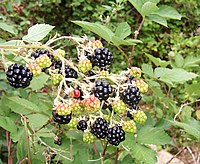
Photo from wikipedia
Abstract A two-year field experiment was conducted to investigate the effects of different intercropping ratios and fertilizer types on antioxidant activity, total phenolic content (TPC), total flavonoids content (TFC) and… Click to show full abstract
Abstract A two-year field experiment was conducted to investigate the effects of different intercropping ratios and fertilizer types on antioxidant activity, total phenolic content (TPC), total flavonoids content (TFC) and content of main flavonoids of buckwheat seeds (Fagopyrum esculentum Moench). The treatments consisted of sole cropping of buckwheat (B), fenugreek (F), and three intercropping ratios (F:B = 1:2, 1:1 and 2:1) under three fertilizer types: chemical fertilizer (CF), integrated fertilizer (IF) and broiler litter (BL). The buckwheat seeds grown in intercropping had higher antioxidant activity measured by DPPH (20.2% in 2014 and 29.6 in 2015) and FRAP (16.9% in 2014 and 29.9% in 2015) assay, TPC (13.6% in both years), TFC (22.9% in 2014 and 11.3% in 2015), flavonoids such as rutin (12.4% in 2014 and 10.8% in 2015), vitexin (10.4% in 2014 and 14.2% in 2015), isovitexin (18.1% in 2014 and 7.8% in 2015), orientin (7.3% in 2014 and 7.07% in 2015), isoorientin (6.6% in 2014 and 9.6% in 2015) and hyperoside (25.1% in 2014 and 27.4% in 2015) than with sole cropping. The intercropping ratio of F:B (2:1) was the most suitable for promoting the tested antioxidant activity and bioactive compounds. Overall, the IF and BL showed significant benefits compared to CF for all detected compounds in both sole and intercrops.
Journal Title: Journal of Cereal Science
Year Published: 2018
Link to full text (if available)
Share on Social Media: Sign Up to like & get
recommendations!